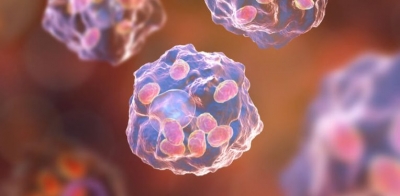
Hungry hunter cells, called macrophages, patrol the human body on the alert for microscopic invaders to engulf and eat.
Part of the immune system, macrophages are white blood cells that target and destroy bacteria to protect the body against infection. In this scan a macrophage is overwhelming harmful tuberculosis (TB) bacteria. TB bacteria usually infect the lung and can cause serious illness if they are allowed to flourish.
Macrophages have evolved a myriad of defense strategies to combat infection with intracellular bacteria such as M. tuberculosis. These include induction of toxic anti-microbial effectors such as nitric oxide and reactive oxygen intermediates, the stimulation of microbe intoxication mechanisms via acidification or metal accumulation in the phagolysosome, the restriction of the microbe’s access to essential nutrients such as iron, fatty acids, or amino acids, the production of anti-microbial peptides and cytokines, along with induction of autophagy and efferocytosis to eliminate the pathogen.
Picture Credit : Google

